One-Shot Wonders: samurai slaughter and zombies
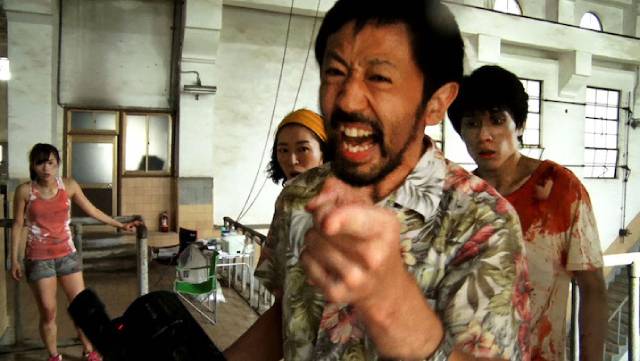
In its beginnings, cinema seemed to offer audiences unmediated access to reality. The first brief movies were single extended shots of some actual event – a train arriving at a station, workers leaving a factory; eventually movement was added in “phantom rides” with the camera mounted on trains, cars, buses in order to travel through both urban and natural spaces – but it didn’t take long for filmmakers to begin using the apparatus to stage imagined events. What had begun as a novelty, a way to make photographic images move, soon became a means of staging an illusion of reality, of telling visual jokes (a boy messing with a gardener’s watering hose) and eventually stories. In very little time, this illusionist tendency subsumed the recording of reality; with the discovery of the possibilities of editing – joining one shot to another as a way of elaborating a narrative – and optical techniques which could give a sense of physical reality to events which existed only within the image itself, rather than presenting unmediated reality, cinema co-opted reality as a vehicle for illusion, an expression of the filmmaker’s imagination.
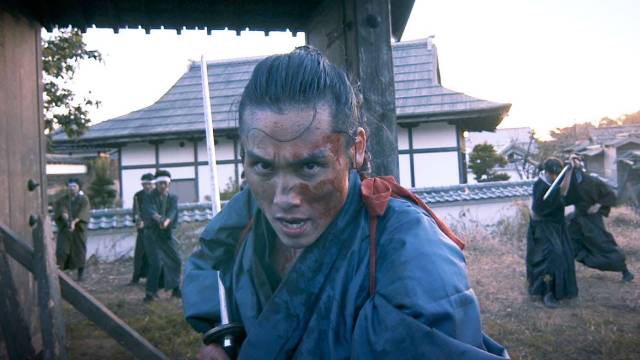
This tension between artifice and the photographic record of some kind of reality runs through the history of film, sometimes leaning far to one side (the extreme fragmentation of Soviet montage), sometimes to the other (a tendency to use a static camera to shoot what essentially resembles a stage performance). Various filmmakers refined available techniques as they explored ways of immersing audiences in the stories they were telling. Directors like Jean Renoir, William Wyler and Orson Welles combined editing with an attempt to maintain the spacial and temporal integrity of the dramatic scene, staging action in depth in long takes.
The idea of telling a long, dramatic story in a single shot has its roots in those earliest brief movies in which reality seemed “pure”, an experience unmediated by artifice. The irony is that such an attempt is itself an exercise in artifice. The manipulation of perception through fragmentation and recombination has to be replaced by a more elaborately mobile camera in order to shift viewer attention according to the needs of the drama.
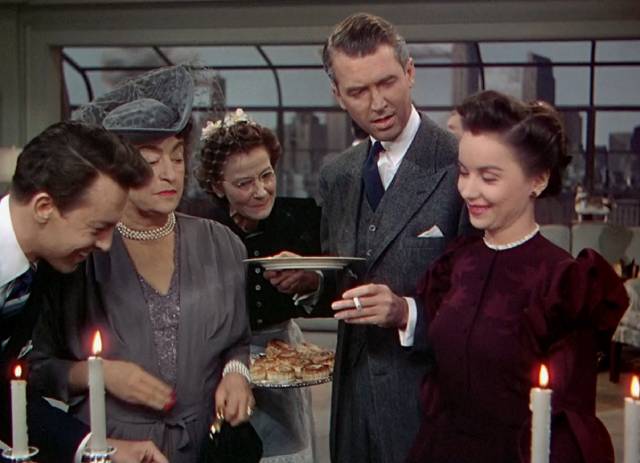
The most famous early attempt at this was Alfred Hitchcock’s Rope (1948), in which the director tried to give the impression of a single continuous take. The technology available – large heavy cameras, limited magazine capacity, clumsy sound recording equipment – imposed its own limitations, not least in the fact that it was necessary to change film reels every ten minutes; Hitchcock had to design hidden points to conceal these interruptions, meaning that despite the intention there was still editing involved, even if it was only splicing together the separate reels. The main problem with Rope is that the technique forces Hitchcock to limit everything to a single set (the movie is a filmed stage play), while the necessity of moving the heavy camera to create moments of emphasis normally achieved through simple editing imposes a sluggish pace – when the James Stewart character notices the detail inside the hat, he has to hold it still while the camera rolls in to take a look and then rolls back out, stripping that detail of its actual dramatic impact and turning it into a lumbering bit of exposition.
Other filmmakers fared better with long takes within a more highly edited context – people like Michelangelo Antonioni, Andrei Tarkovsky, Theo Angelopoulos and Bela Tarr were masters of this, using the uninterrupted take as a way of conveying a visceral sense of time and space, while nonetheless controlling the overall narrative flow of their films with a combination of sustained camera movement and judicious editing. But with the advent of accessible video equipment, a lot of the drawbacks of this technique on film were eliminated. No need for reel changes and disguised cuts; no need for dollies because the cameras were sufficiently lightweight for extended handheld use; and the availability of radio mics left performers free to move without restriction.
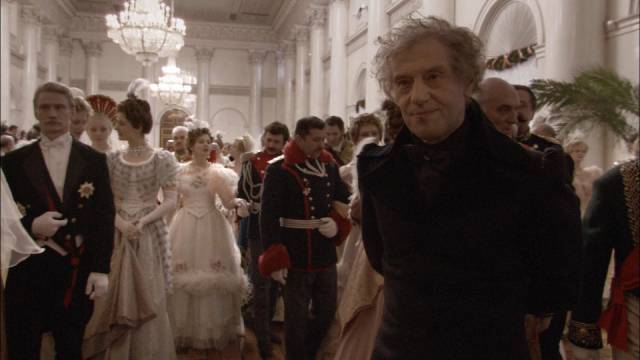
Whether the possibility of a single-shot movie might be a worthwhile endeavour or merely an excuse to show off is debatable, but there have been some very interesting results as different filmmakers experiment with the technique. To pick just two examples: Mike Figgis’ Timecode (2000) and Aleksandr Sokurov’s Russian Ark (2002) take very different approaches, each involving extremely complex technical difficulties. Sokurov’s film uses a “tour” of the Hermitage Museum to convey two-hundred years of Russian history and art, bringing multiple periods to life as his camera follows a 19th Century French aristocrat from room to room. While the viewer is entranced by the visual spectacle, he/she can’t help but be aware of the incredible logistical task of coordinating hundreds of performers as the camera passes among them for an-hour-and-a-half.
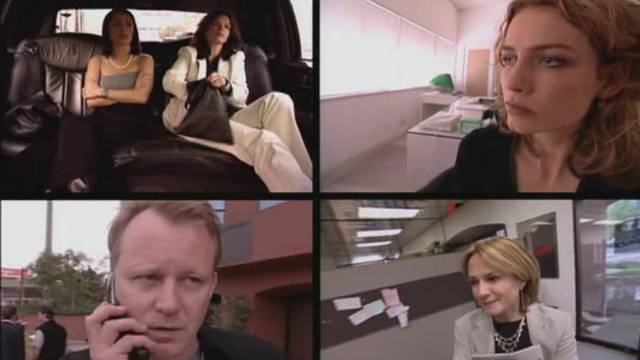
Figgis took on a very different challenge with his melodrama about business and relationships in the movie industry in Los Angeles. Using four separate cameras, each shooting continuously as it follows certain characters whose lives repeatedly intersect in various locations, he places the four images in a grid which allows the viewer to shift attention from one focus point to another, in effect performing the editing function with his/her own eyes. In initial screenings, Figgis would set up a mixing board in the theatre and play in real time with the four intermingled soundtracks. With more than two dozen characters, each with their own concerns and personal problems, the film becomes an active audience exercise in creating narrative from seemingly raw experience. But of course, as in Sokurov’s film, this “raw” material is the result of a massive logistical effort – coordinating four cameras and multiple performers in multiple locations, all of which have to intersect at specific moments, was a phenomenal achievement. (The DVD provides an excellent glimpse of this challenge, not simply with Figgis’ commentaries, but through the inclusion of both the “first take” and the final theatrical version, which was take 15, which allows you to see how the logistics were refined as the entire film was re-shot each day for two weeks. On the theatrical version, it’s also possible to switch between the four audio tracks to focus on whichever thread you want to at any particular moment.)
There are quite a few of these one-shot movies (or movies which, like Rope, try to give the impression of being one-shot) – Wikipedia has a page which lists more than four dozen, some of them running around two-and-a-half hours, many of which I haven’t seen (including prominent examples like Sebastian Schipper’s Victoria [2015] and Sam Mendes’ 1917 [2019]). However, I did just watch a couple of recent Japanese examples, one not entirely successful, the other quite brilliant in its self-conscious deconstruction of the form.
*
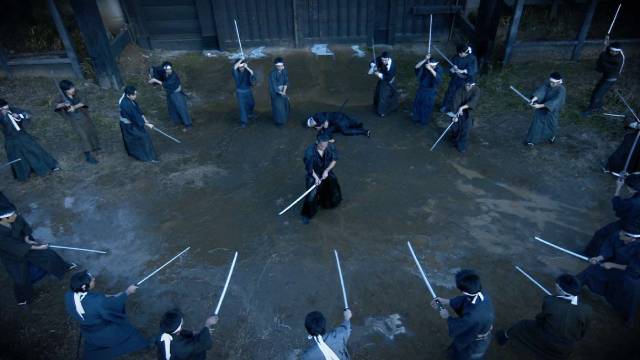
Crazy Samurai Musashi: 400 vs 1
(Yuji Shimomura, 2020)
Action director and stuntman Yuji Shimomura has teamed up three times with actor Tak Sakaguchi, each time in what amounts to an experiment in action filmmaking techniques. Shimomura doesn’t display much interest in storytelling itself, which means these three movies are thin on basics like narrative and character; they exist solely for the purpose of constructing dynamic displays of kinetic violence. Their first collaboration, Death Trance (2005) was a kind of live-action anime fantasy; the second, Re:Born (2016), was a grim and gritty tale of an ex-soldier taking on members of his old unit in a series of visceral, up-close knife fights; the third is a variation on classic samurai films.
Crazy Samurai Musashi (2020) covers a single incident in the life of the legendary Miyamoto Musashi (1584-1645), a figure who has appeared in many movies over decades. In this instance, the “hero” – who we first encounter as he kills a young boy and an unarmed old man – single-handedly takes on an entire clan of swordsmen numbering in the hundreds. Although the prologue and epilogue are filmed in conventional style, the body of the film is a single shot in which the camera moves with Musashi through a village and surrounding country as he slices his way through groups of armed opponents.
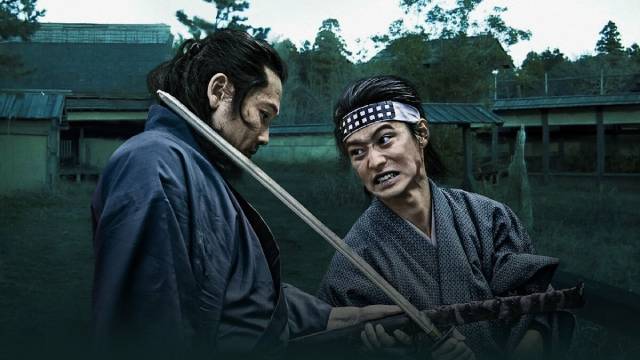
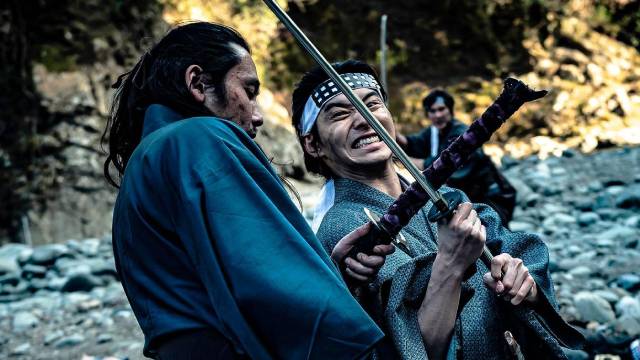
Although, Shimomura provides occasional moments of inaction to allow the character (and the actor) to catch his breath, the action grinds on for more than eighty minutes. It’s exhausting and repetitive, and since the whole point is a display of physical endurance and all those samurai exist only to be cut down, there’s a total absence of actual characters (including Musashi himself). It’s all about the mechanics of killing and the logistics of the staging. And therein lies the real problem…
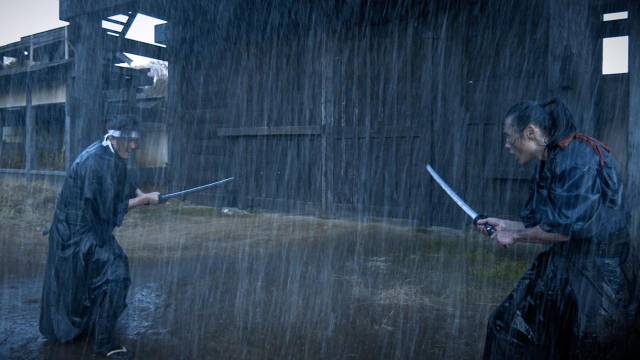
Although elaborately choreographed, the one-shot method precludes the use of effects to add a visceral quality to the combat. Even as Musashi cuts down dozens after dozens of opponents, it’s all strangely bloodless – until well into the running time, when Shimomura does begin to add a few digital blood splashes, which remain unconvincing. On top of that, there’s the issue of the accumulating bodies – obviously the budget didn’t extend to hiring four-hundred stunt performers, so recycling quickly becomes a necessity. We actually see supposedly injured samurai staggering (sometimes running) out of frame in order to come around and resume the fight as “another” character, which means that no matter how many men Musashi kills, the landscape remains largely unlittered with bodies.
The paradox is that the logistical requirements of a technique intended to convey a sense of reality end up making the relentless action seem contrived and fake; conventional techniques, with multiple set-ups and editing, would not only have enabled Shimomura to inject moments of character which might have added tension and dramatic weight to the protracted fight; they would also have enabled him to use makeup effects to increase the visceral quality of the combat. As it is, the one-take gimmick simply draws attention to the choreography and the lack of actual physical contact between the performers.
*
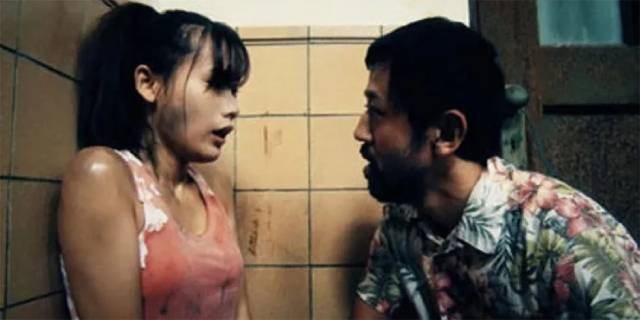
One Cut of the Dead (Shin’ichiro Ueda, 2017)
Before watching it, all I knew about Shin’ichiro Ueda’s One Cut of the Dead (2017) was that it was a zombie comedy which included a long one-take section. That take constitutes the movie’s first thirty-seven minutes and it’s an interesting, if seemingly not entirely successful exercise in low-budget horror filmmaking. It begins with a young woman, Chinatsu (Yuzuki Akiyama), backing away from her now walking-dead boyfriend Ko (Kazuaki Nagaya). As he closes in and puts the bite on her neck, we suddenly hear “cut” and irate director Higurashi (Takayuki Hamatsu) begins berating her for her inability to convey real fear. This was the forty-second take and she’s still not giving him what he wants.
As the camera pulls away, we see the crew surrounding them, including another camera which has been shooting the scene. So this is a low-budget production shooting a cliched horror movie – but already there’s a question: what’s with the camera we don’t see, the one recording the shooting of the scene? As everyone takes a break and the director goes to cool off, members of cast and crew disperse in the abandoned industrial building where they’re shooting. We stick with Chinatsu, Ko and makeup artist Nao (Narumi Shuhama), who chat idly to pass the time. There’s a noise outside, but they ignore it … until an actual zombie shows up, one of the crewmembers who had gone outside.
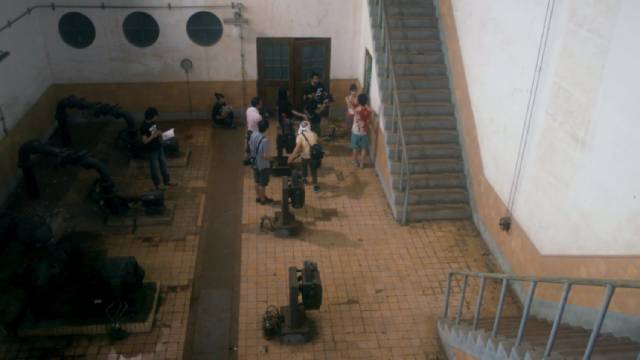
From this point, Chinatsu is fighting for her life as more cast and crew members succumb to the contagion, all aggravated by Higurashi, who insists on continuing to film, particularly now that he’s getting genuine fear from Chinatsu. Things get increasingly frenetic, with the action escalating in and around, and eventually on top of, the building. But there are occasional glitches which remind us that someone still remains outside the action, recording what’s going on – this is not the zombie movie’s cinematographer, because we still see him at work. This additional layer raises the usual questions which plague found-footage movies – who keeps shooting as things keep getting more dangerous?
At one point this unseen camera operator falls during a fight and the camera just lies on the ground as the action moves out of frame; after a while, the camera is lifted and resumes pursuit of the action. Later, up on the roof, as Chinatsu is menaced by a now-zombified crewmember, the camera holds on her as she screams and screams … and screams. It just goes on until it becomes irritating and you wonder why the damn camera doesn’t move to show what she’s screaming at. But then things begin moving again and as we reach a climactic revelation the camera cranes up and credits begin to roll. Thirty-seven minutes in, the movie is over…
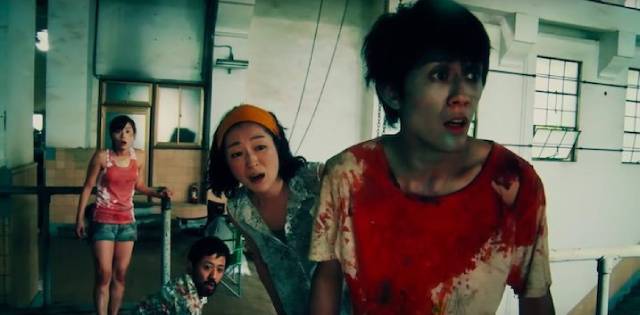
Except at this point we step back once more to reveal an even larger crew which has been shooting a movie about a film crew shooting a movie about zombies who have found themselves attacked by “real zombies”. At which point we jump back in time to a meeting at which Higurashi is approached by people who are launching a new cable channel with a proposition – to launch the channel with a live production about a film crew making a zombie movie who are attacked by real zombies, all to be done in a continuous take with a single camera.
From here, we get all the preparation – writing the script, putting together a crew, casting the roles – leading up to the actual live production, which we now see from the outside from multiple angles. This second half of the film is both brilliant comedy and an exhilarating dissection of the creative process under pressure, as things inevitably go wrong and Higurashi (who takes on the role of director in the film-within-the-film when someone drops out at the last minute) has to improvise to keep things going. Here we get to see what was actually behind all those odd glitches and realize that they were markers of production hitches which needed to be dealt with on the fly in order for the live recording not to collapse completely.
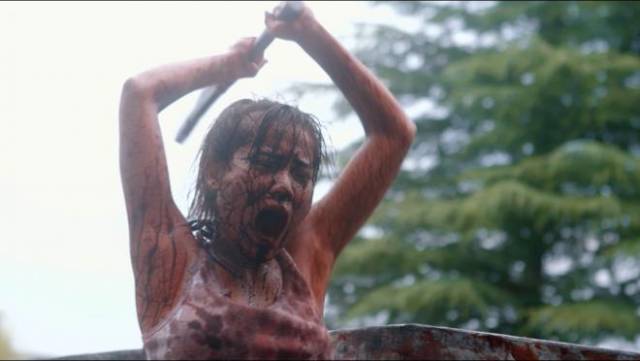
One Cut of the Dead is a wonderful, insightful depiction of movie-making which suggests that we might need to be more tolerant of what appear to be mistakes in what we watch. Funny and generous in spirit, it transforms the gimmick of the one-shot movie into a metaphor for the combination of meticulous planning and contingency which occurs in the act of imaginative creation. And if I find it difficult to apply its lessons retroactively to a film like Crazy Samurai Musashi, it’s because unlike Ueda’s film, Shimomura’s gives us no characters to engage with emotionally. Crazy Samurai Musashi is all mechanics, while One Cut of the Dead is about the heart which makes the mechanics work.
Third Window Films’ Blu-ray adds more layers with a 43-minute making-of which shows how the idea was workshopped by Ueda with the cast and crew – roles were only assigned to specific performers late in the process after the actors, most appearing in a film for the first time, had tried multiple positions with Ueda eventually deciding where each was best suited. The one-take was extensively rehearsed in studio and then on location, and finally shot a number of times before everything worked out as intended; and then it was all reworked as the film’s “behind the scenes” final hour. To give a clearer idea of what was involved in making the one-take, Ueda strapped on a GoPro and followed behind the actual cameraman. This 38-minute continuous record is included on the disk, showing the exhausting work involved, particularly what the cameraman and sound recordist had to go through in following the flow of the action without getting tangled up with the actors.
There’s also an interview with Ueda, a brief selection of deleted scenes and a trailer.
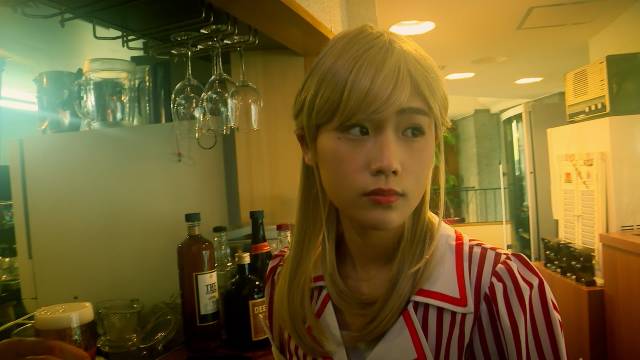
in Yuya Nakaizumi’s One Cut of the Dead: In Hollywood (2019)
Finally, there’s a kind of sequel, One Cut of the Dead: In Hollywood (2019), a one-hour variation written by Ueda, but directed by Yuya Nakaizumi, with some of the same actors. Although there are some amusing elements (originally planned to be shot in Hollywood, this follow-up commissioned by the same cable channel has to fake Los Angeles in Japan when the budget is severely cut), it plays more like a comedy skit than the original’s sophisticated meditation on filmmaking. Chinatsu, having survived the zombie attack in One Cut, has lost the ability to speak and moved to Hollywood, where she works as a waitress in a restaurant. It’s her bad luck that there’s another zombie outbreak. Being in the States, this time guns are involved. The initial section isn’t up to the standard set in the original movie, but when we get to the “behind-the-scenes” second half there are some amusing touches dealing with the ways in which the crew try to fake the American location in a Japanese neighbourhood (lacking western extras, they simply put blonde wigs on a bunch of Japanese performers).
Comments